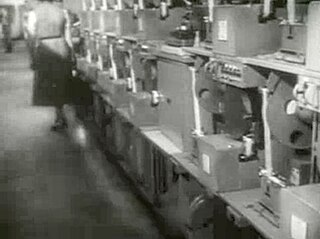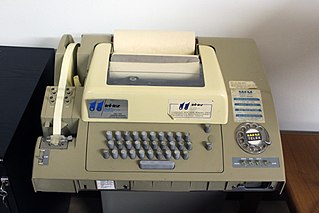Related Research Articles
The Simple Mail Transfer Protocol (SMTP) is an Internet standard communication protocol for electronic mail transmission. Mail servers and other message transfer agents use SMTP to send and receive mail messages. User-level email clients typically use SMTP only for sending messages to a mail server for relaying, and typically submit outgoing email to the mail server on port 587 or 465 per RFC 8314. For retrieving messages, IMAP is standard, but proprietary servers also often implement proprietary protocols, e.g., Exchange ActiveSync.

Short Message/Messaging Service, commonly abbreviated as SMS, is a text messaging service component of most telephone, Internet and mobile device systems. It uses standardized communication protocols that let mobile devices exchange short text messages. An intermediary service can facilitate a text-to-voice conversion to be sent to landlines.

A teleprinter is an electromechanical device that can be used to send and receive typed messages through various communications channels, in both point-to-point and point-to-multipoint configurations. Initially they were used in telegraphy, which developed in the late 1830s and 1840s as the first use of electrical engineering, though teleprinters were not used for telegraphy until 1887 at the earliest. The machines were adapted to provide a user interface to early mainframe computers and minicomputers, sending typed data to the computer and printing the response. Some models could also be used to create punched tape for data storage and to read back such tape for local printing or transmission.

An open mail relay is a Simple Mail Transfer Protocol (SMTP) server configured in such a way that it allows anyone on the Internet to send e-mail through it, not just mail destined to or originating from known users. This used to be the default configuration in many mail servers; indeed, it was the way the Internet was initially set up, but open mail relays have become unpopular because of their exploitation by spammers and worms. Many relays were closed, or were placed on blacklists by other servers.

An email client, email reader or, more formally, message user agent (MUA) or mail user agent is a computer program used to access and manage a user's email.
An anonymous remailer is a server that receives messages with embedded instructions on where to send them next, and that forwards them without revealing where they originally came from. There are cypherpunk anonymous remailers, mixmaster anonymous remailers, and nym servers, among others, which differ in how they work, in the policies they adopt, and in the type of attack on the anonymity of e-mail they can resist. Remailing as discussed in this article applies to e-mails intended for particular recipients, not the general public. Anonymity in the latter case is more easily addressed by using any of several methods of anonymous publication.
In telecommunications, message switching involves messages routed in their entirety, one hop at a time. It evolved from circuit switching and was the precursor of packet switching.
Various anti-spam techniques are used to prevent email spam.
In computer networking, cut-through switching, also called cut-through forwarding is a method for packet switching systems, wherein the switch starts forwarding a frame before the whole frame has been received, normally as soon as the destination address and outgoing interface is determined. Compared to store and forward, this technique reduces latency through the switch and relies on the destination devices for error handling. Pure cut-through switching is only possible when the speed of the outgoing interface is at least equal or higher than the incoming interface speed.
Greylisting is a method of defending e-mail users against spam. A mail transfer agent (MTA) using greylisting will "temporarily reject" any email from a sender it does not recognize. If the mail is legitimate, the originating server will try again after a delay, and if sufficient time has elapsed, the email will be accepted.
A bounce message or just "bounce" is an automated message from an email system, informing the sender of a previous message that the message has not been delivered. The original message is said to have "bounced".
GSM services are a standard collection of applications and features available over the Global System for Mobile Communications (GSM) to mobile phone subscribers all over the world. The GSM standards are defined by the 3GPP collaboration and implemented in hardware and software by equipment manufacturers and mobile phone operators. The common standard makes it possible to use the same phones with different companies' services, or even roam into different countries. GSM is the world's most dominant mobile phone standard.
Email authentication, or validation, is a collection of techniques aimed at providing verifiable information about the origin of email messages by validating the domain ownership of any message transfer agents (MTA) who participated in transferring and possibly modifying a message.
The Sender Rewriting Scheme (SRS) is a scheme for bypassing the Sender Policy Framework's (SPF) methods of preventing forged sender addresses. Forging a sender address is also known as email spoofing.
Winlink, or formally, Winlink Global Radio Email, also known as the Winlink 2000 Network, is a worldwide radio messaging system that uses amateur-band radio frequencies and government frequencies to provide radio interconnection services that include email with attachments, position reporting, weather bulletins, emergency and relief communications, and message relay. The system is built and administered by volunteers and is financially supported by the Amateur Radio Safety Foundation.
Forwarding may refer to:
SMTP proxies are specialized mail transfer agents (MTAs) that, similar to other types of proxy servers, pass SMTP sessions through to other MTAs without using the store-and-forward approach of a typical MTA. When an SMTP proxy receives a connection, it initiates another SMTP session to a destination MTA. Any errors or status information from the destination MTA will be passed back to the sending MTA through the proxy.
Email forwarding generically refers to the operation of re-sending a previously delivered email to an email address to one or more different email addresses.

Automatic Telegraph Switching System Plan 55-A was one in a series of store and forward message switching systems developed by Western Union and used from 1948 to 1976 for processing telegrams. It is an automated successor to Plan 51, which commenced service in 1951 in a nationwide network of the U.S. Air Force, but required semi-automatic operation.

The telex network is a station-to-station switched network of teleprinters similar to a telephone network, using telegraph-grade connecting circuits for two-way text-based messages. Telex was a major method of sending written messages electronically between businesses in the post–World War II period. Its usage went into decline as the fax machine grew in popularity in the 1980s.
References
- ↑ Beck, M.; Moore, T.; Plank, J.; Swany, M.:"Logistical Networking", Active Middleware Services, pp. 141-154. Springer US, 2000
- "Switches — What Are Forwarding Modes and How Do They Work?". Archived from the original on 2014-04-19.